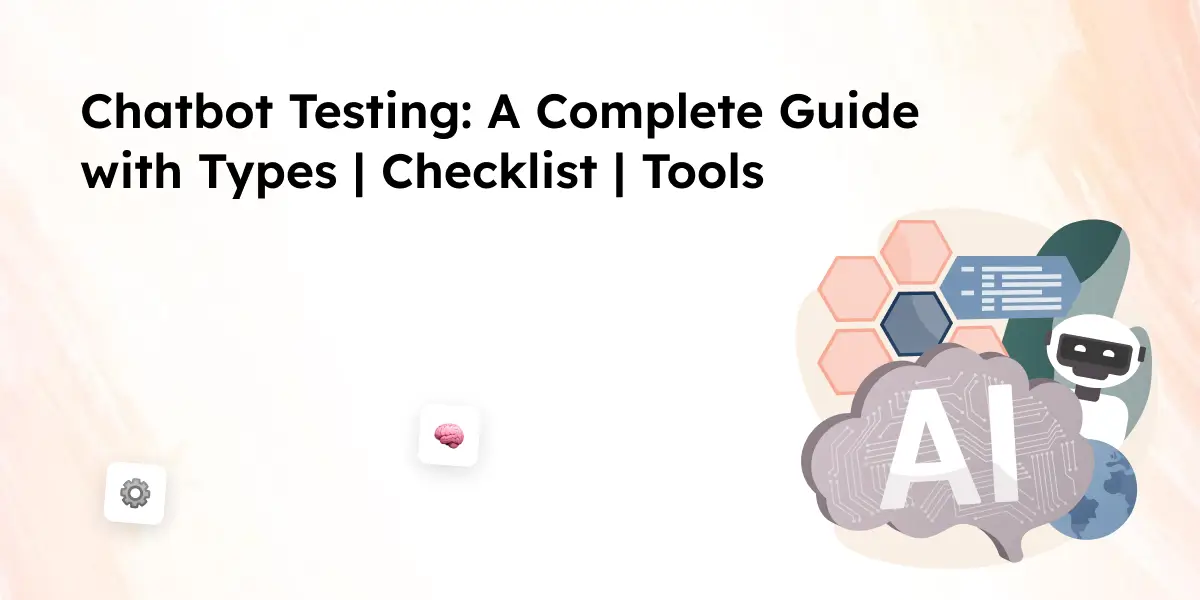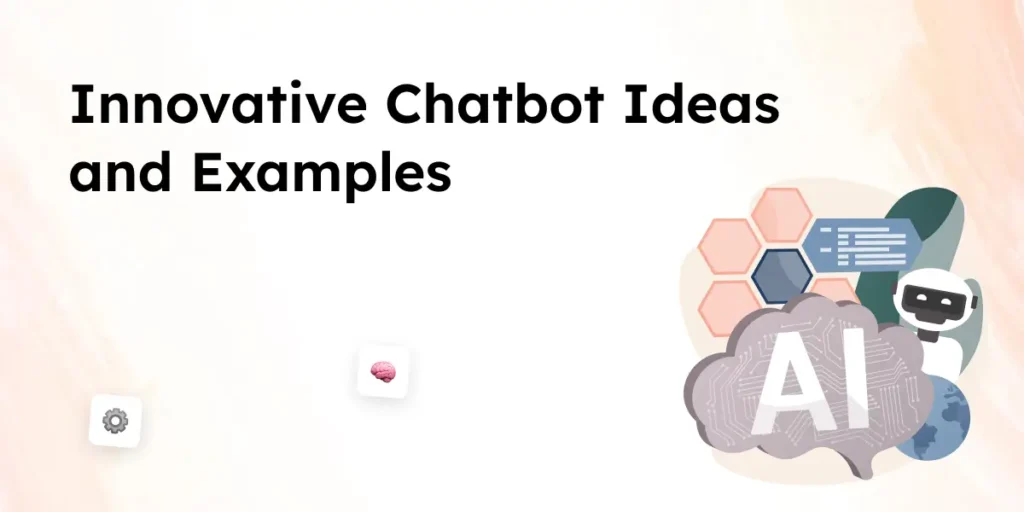Chatbot testing ensures that AI chatbots respond accurately and provide a smooth user experience. Without thorough testing, chatbots may fail to understand inputs or give incorrect replies. Testing involves verifying chatbot functionality, performance, and security while assessing its ability to handle different queries and maintain conversation flow.
Businesses can choose between manual testing and automated testing tools based on their needs. This guide covers chatbot testing types, best practices, and a checklist to help automate chatbot testing, ensuring reliable chatbot interactions and a seamless user experience before deployment.
Why Testing Chatbots is Important
Testing a chatbot is necessary to make sure it works as expected and provides a smooth user experience. Businesses use AI chatbots to manage customer inquiries, automate responses, and improve efficiency. Without chatbot testing, problems like incorrect replies, failure to understand user intent, or conversation breakdowns can happen.
Key Reasons Why Chatbot Testing is Crucial
- Ensures accurate responses
- The chatbot must recognize different ways users phrase their questions.
- Prevents misunderstandings that could lead to customer frustration.
- Validates chatbot automation
- Automated replies should be accurate, timely, and relevant.
- Pre-launch testing helps confirm the chatbot responds appropriately before it goes live.
- Improves user experience
- A chatbot that replies too slowly or incorrectly can affect customer satisfaction.
- Regular bot testing helps maintain smooth chatbot interactions and conversation flow.
- Strengthens security measures
- Security testing helps identify vulnerabilities in AI-powered chatbots.
- Ensures compliance with data protection rules to safeguard user data.
- Supports continuous improvement
- Regular testing helps improve chatbot functionality over time.
- Chatbot testing tools assist in finding and fixing errors efficiently.
- Enhances business efficiency
- Automated chatbots reduce workload, but testing ensures they work effectively.
- Businesses can trust their chatbot to provide reliable and consistent support.
Testing helps businesses refine chatbot responses, improve accuracy, and enhance conversational AI interactions. A structured testing approach prevents chatbot failures, boosts customer engagement, and ensures the chatbot provides meaningful support.
Types of Testing for AI Chatbots
Testing a chatbot involves different methods to ensure that it performs well under various conditions. Each type of testing focuses on a specific aspect of chatbot functionality, from understanding user input to handling high traffic. Using a mix of manual and automated testing tools helps cover all critical areas.
Functional Testing
- Ensures the chatbot responds correctly to user queries.
- Checks if the chatbot handles different conversation flows properly.
- Identifies errors in chatbot design and conversation structure.
- Helps test cases that cover various user intents and responses.
Performance Testing
- Measures chatbot performance under different loads.
- Tests response times to ensure quick interactions.
- Evaluates chatbot stability during peak usage periods.
- Uses test automation to simulate high traffic conditions.
Conversational Testing
- Assesses the chatbot’s ability to understand different ways users phrase questions.
- Ensures smooth and natural chatbot conversations.
- Checks whether the chatbot provides consistent and relevant answers.
- Identifies areas where chatbot interactions could be improved.
Security Testing
- Identifies potential security risks and vulnerabilities.
- Ensures the chatbot complies with data privacy regulations.
- Protects sensitive user information from unauthorized access.
- Helps businesses maintain trust in their chatbot.
Usability Testing
- Evaluates how easy it is for users to engage with a chatbot.
- Gathers feedback on the chatbot’s ability to guide users efficiently.
- Helps improve chatbot replies and user experience.
- Identifies any friction points in the chatbot conversation flow.
Regression Testing
- Ensures new updates do not break existing chatbot functionality.
- Checks whether previous chatbot issues have been fixed.
- Uses automated testing tools to speed up the process.
- Helps maintain chatbot evolution without introducing errors.
Pre-Launch Testing
- Runs thorough testing to ensure the chatbot is ready for deployment.
- Tests chatbot responses across different devices and platforms.
- Ensures chatbot automation works correctly in real-world conditions.
- Confirms that chatbot testing tools have covered all major scenarios.
By using a combination of these testing techniques, businesses can ensure their chatbot performs well across various situations. Testing chatbot capabilities regularly helps improve chatbot interactions and ensures that the chatbot consistently meets user needs.
Chatbot Testing Strategies and Techniques
A structured testing approach is necessary to ensure that a chatbot functions correctly in real-world scenarios. Businesses need to follow a well-defined strategy that includes different testing techniques to improve chatbot interactions and enhance the overall user experience.
Choosing the Right Testing Approach
- A mix of manual testing and automated testing tools helps cover different aspects of chatbot performance.
- Manual testing allows for real-time human evaluation of chatbot responses.
- Automating your testing speeds up the process and ensures consistency.
- Test automation helps simulate large volumes of interactions efficiently.
AI-Powered Testing Techniques
- AI can analyze chatbot responses to improve accuracy over time.
- Automated test cases help detect issues faster and reduce errors.
- AI chatbot testing ensures the chatbot handles different phrasings effectively.
- Conversational AI testing verifies the chatbot’s ability to engage in natural interactions.
Continuous Monitoring and Improvement
- Chatbot testing is crucial for long-term success, requiring frequent evaluation.
- Regression testing helps confirm that updates do not negatively affect chatbot functionality.
- Chatbot performance should be analyzed regularly to detect potential issues.
- Testing multiple chatbot versions helps compare improvements and identify weak points.
Best Practices for Effective Chatbot Testing
- Run pre-launch testing to check the chatbot across multiple devices and platforms.
- Ensure that your chatbot can handle unexpected inputs and errors smoothly.
- Use chatbot testing tools to automate chatbot testing for efficiency.
- Create a set of test cases that cover various conversational flows and possible user inputs.
- Perform conversation testing to ensure chatbot replies are relevant and well-structured.
By applying a strong testing strategy and using advanced testing techniques, businesses can ensure their chatbot provides a seamless experience. Following a structured testing process helps prevent chatbot failures, reduces errors, and maintains chatbot automation efficiency.
Chatbot Testing Checklist
A chatbot testing checklist helps businesses ensure their chatbot is ready for deployment. It covers different aspects of chatbot functionality, from understanding user input to handling errors effectively. Following a structured approach makes chatbot testing more thorough and reliable.
1. Intent Recognition
- Test the chatbot’s ability to understand different ways users phrase their questions.
- Ensure that the chatbot correctly identifies user intent across various test scenarios.
- Check how well the chatbot handles ambiguous or incomplete queries.
2. Entity Extraction
- Verify that the chatbot correctly recognizes key details such as names, dates, and locations.
- Ensure the chatbot provides accurate responses based on extracted information.
- Test scenarios where users provide partial or incorrect data.
3. Response Accuracy
- Test the chatbot’s ability to provide relevant and correct answers.
- Ensure chatbot replies remain consistent across different conversation flows.
- Identify cases where the chatbot provides incorrect or incomplete responses.
4. Conversation Flow
- Test chatbot interactions to confirm they follow a logical sequence.
- Check whether the chatbot correctly switches between topics when needed.
- Ensure the chatbot provides smooth transitions between different types of user queries.
5. Error Handling
- Test how the chatbot responds to unknown inputs or off-topic questions.
- Ensure chatbot automation includes fallback responses when needed.
- Evaluate whether chatbot responses guide users back on track effectively.
6. Performance Testing
- Check if the chatbot performs well under high user traffic.
- Ensure chatbot automation allows for quick response times.
- Simulate heavy usage with automated testing tools to assess chatbot performance.
7. Security Testing
- Ensure chatbot security measures protect user data.
- Test chatbot compliance with data protection laws and privacy standards.
- Identify and fix potential security vulnerabilities.
8. Multi-Platform Compatibility
- Test the chatbot across different devices and operating systems.
- Ensure chatbot functionality remains consistent on web, mobile, and messaging platforms.
- Identify any platform-specific issues that might impact chatbot performance.
9. Pre-Launch Testing
- Run thorough testing to ensure chatbot functionality before deployment.
- Conduct usability testing to confirm chatbot interactions are user-friendly.
- Use chatbot testing tools to automate chatbot testing and validate chatbot readiness.
By following this chatbot testing checklist, businesses can identify weaknesses and improve chatbot performance before launch. Regular testing helps refine chatbot interactions and ensures that the chatbot provides a seamless experience across different scenarios.
Automating Your Testing: Tools and Best Practices
Automating your testing improves efficiency and ensures chatbots maintain high performance. While manual testing helps assess chatbot interactions in real time, automation testing speeds up the process and reduces errors. Using the right testing tools allows businesses to streamline chatbot evaluation and improve response accuracy.
1. Benefits of Test Automation for Chatbots
- Reduces the time needed to test chatbot functionality across different scenarios.
- Helps identify errors faster by running automated test cases.
- Ensures chatbot automation works correctly without manual intervention.
- Supports continuous testing for chatbot evolution and performance improvement.
2. Best Tools for Automating Your Testing
Businesses can use various chatbot testing tools to automate chatbot testing. Tools like these help assess chatbot interactions, conversation flow, and response accuracy.
- Botanalytics – Provides insights into chatbot conversations and user interactions.
- Dimon – Automates chatbot testing across different messaging platforms.
- Chatbottest – Offers a structured approach to test chatbot interactions effectively.
3. Best Practices for Automation Testing
- Use a mix of manual testing and automated testing tools to get the best results.
- Develop test cases that cover different chatbot responses and user intents.
- Ensure that the chatbot handles unexpected inputs smoothly.
- Run regression testing to confirm that updates do not break chatbot functionality.
- Implement security testing to protect user data and prevent vulnerabilities.
- Perform pre-launch testing to validate chatbot performance before going live.
- Monitor chatbot responses regularly to ensure that chatbot interactions remain accurate.
By incorporating automation testing into chatbot development, businesses can improve efficiency and maintain chatbot consistency. Regular testing ensures chatbot functionality remains stable, reducing errors and enhancing chatbot performance.
Conclusion and Final Thoughts
Chatbot testing is essential for ensuring smooth interactions and optimizing chatbot performance. Businesses use AI chatbots to automate customer support, but without thorough testing, issues like incorrect responses and poor conversation flow can arise. A combination of manual and automated testing helps identify errors, refine chatbot automation, and improve chatbot functionality.
Pre-launch testing ensures the chatbot is ready for real-world use, while continuous testing helps it evolve. Security testing protects user data and prevents vulnerabilities. By following a chatbot testing checklist and best practices, businesses can enhance chatbot engagement, build trust, and provide a seamless conversational experience.
Frequently Asked Questions (FAQ) About Chatbot Testing
1. Why is chatbot testing important?
Chatbot testing is crucial to ensure that a chatbot understands user input, responds accurately, and provides a smooth user experience. Without proper testing, chatbots may misinterpret questions, give incorrect replies, or fail to maintain conversation flow.
2. What are the main types of chatbot testing?
Chatbot testing includes functional testing, performance testing, conversational testing, security testing, usability testing, and regression testing. Each type helps improve chatbot automation, accuracy, and stability.
3. How does automated testing improve chatbot performance?
Automating your testing speeds up the process, ensures consistency, and helps identify errors more efficiently than manual testing. Automated testing tools simulate user interactions, check chatbot replies, and verify chatbot functionality across different test cases.
4. What is pre-launch testing, and why is it necessary?
Pre-launch testing ensures that the chatbot is fully functional before it goes live. It involves testing chatbot interactions, chatbot responses, and security measures to identify potential issues early.
5. What are some common chatbot testing tools?
Popular chatbot testing tools include Botanalytics, Dimon, and Chatbottest. These tools help businesses automate chatbot testing, track chatbot performance, and optimize chatbot interactions.



